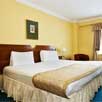Getting around Belfast
By bus
The centre of Belfast is small enough to be explored by foot. Translink operate Belfast's urban bus network, called Metro (previously Citybus). Buses run along colour coded high frequency routes that radiate from the city centre from around 6AM until 11PM. All major bus routes start or pass through Donegall Square, and a Metro information kiosk is on the north-western side of the square.
Tourist passes are available from here, or for the more frequent traveller, you can purchase and pre-load a Smartlink card with credit for bus trips. While the routes are extensive, the travel is expensive, as it is for the whole of the country. Buses frequently do not turn up and staff can at times be unhelpful.
There are no buses or trains running during the night (except to the airports), so your only option is to take a taxi if you need to travel anywhere you cannot walk to.
If your time is limited, the open-top 'Belfast Sightseeing' bus tours are recommended, costing about £10 per person for a 2 hour journey. You will be shown the sights in the city centre and suburbs including famous murals painted on the ends of terraced houses during 'The Troubles' in the Falls Road area, the Harland and Wolff shipyards where the Titanic was built and Queens University. The guides are friendly, well informed and interesting, although many locals still remark that is unusual to see bright red open top tour buses passing through once troubled neighbourhoods. You may prefer a less obvious exploration of the city

Image: City Hall, Belfast
Black Taxi Tours
Belfast is now famous for its Black Taxi tours of the city, which are highly recommended, and can be arranged by most hostels, hotels and at the tourist office (47 Donegall Place, above the Boots pharmacy, just north of the City Hall). These tours are given by regular taxi drivers who have worked through the troubled years, and have a wealth of knowledge and very personal experiences, which they are glad to share during a tour that can last up to two hours.
Also of interest are the shared taxi routes of North and West Belfast. These run along set routes and cost around £1, no matter how long the journey. Their origins date from the darkest days of the troubles, when city bus services were frequently disrupted by violence and attacks. There are fixed locations in the City Centre where these begin their routes, and will generally queue until filled with 4 or 5 people. Note that minicabs (regular saloon cars with taxi licence plates and illuminated roof signs) generally do not operate as black taxis.
Getting around the Central area of Belfast
Belfast city centre is focused on Donegall Square and Belfast City Hall in its centre. All major city bus routes converge here and, on sunny days, this is where shoppers and office workers can be found enjoying their breaks. The City Hall is the grand centerpiece of the city and the orientation point for your exploration of Belfast. Running north from the centre of Donegall Square is Donegall Place, a broad and bustling shopping street, which will lead you towards the Cathedral Quarter and the Arts School.
The city centre is bordered to the east by the River Lagan, and to the south by the area around Donegall Pass. Where Belfast city centre meets the River Lagan, windswept pavements prove that meaningless sculptures and grandiose attempts at urban planning do not necessarily make for a popular urban space. The horrendous dual carriageway known as the Westlink separated the centre of Belfast from the western suburbs of the city in the 1970s; this borders the city centre to the west. On the plus side, the network of dual carriageways and motorways mean that one can get from the city centre to all the surrounding suburbs and satellite towns in less than fifteen minutes, even during the rush hour, something which is impossible in many other cities, for example Dublin.
In between these rough boundaries, you'll find Belfast's heart. Parts of it are blighted by dereliction, others are blighted by narrow-minded money-grabbing redevelopment. Note that while largely safe at all times, years of city centre curfews during the troubles means that the centre of Belfast can be startlingly empty of pedestrians after 8PM, with groups of teenagers the only people to found on Donegall Pl. City centre living has yet to become as popular here as in other parts of Britain and Ireland.


















